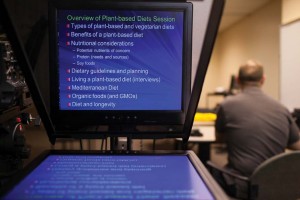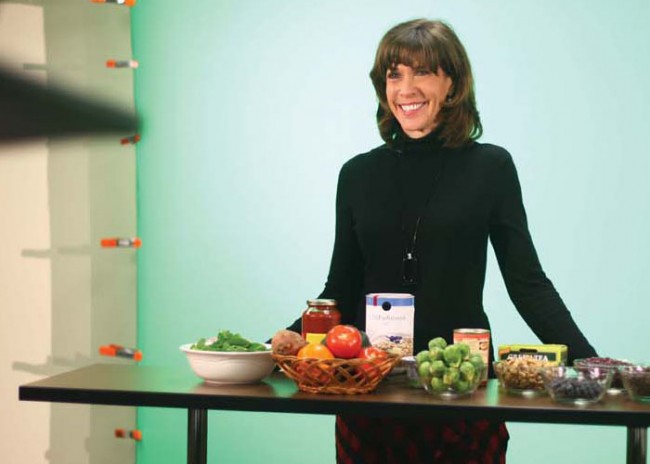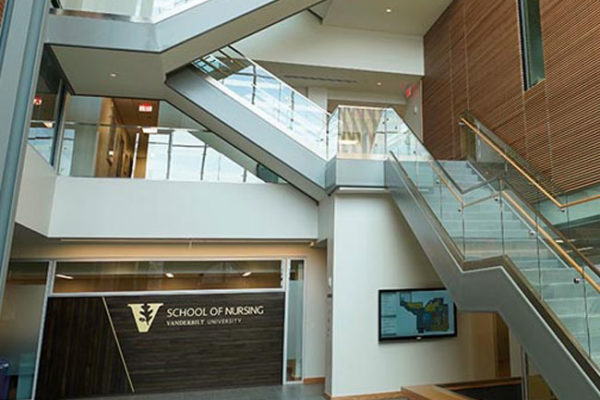Lights. Camera. Action.
Nutrition instructor Jamie Pope lectures to her students on the power of superfoods, with a rainbow-colored collection of nutrient-rich fare on the table before her and a green screen draped behind her.
Her class is 50,000 students strong and growing. Except for a throng of studio lights, camera equipment, computers and a teleprompter, not a single student is present – at least not physically – for the entire seven-week course.
Instead, they will watch the lectures from the comfort of their homes, or perhaps a coffee shop or library, in some cases halfway around the world, and submit all work online.
The course, Nutrition, Health and Lifestyle: Issues and Insights, is a hybrid of Pope’s two current and extremely popular courses within Vanderbilt University’s School of Nursing, Introduction to Nutrition and Nutrition and Health: Issues and Insights. It also serves as one of five pilot courses marking Vanderbilt University’s virtual entrance this spring into the world of MOOCs, or Massive Open Online Courses, on the digital learning platform Coursera.
With an established history in digital learning more than a decade long, the School of Nursing was an obvious department to include in the Coursera endeavor while Pope’s far-reaching nutrition expertise was a prime pick for a broad and far away audience.
“I think the practical application aspect of my course has made it appealing,” said Pope, MS, RD, LDN. “I’ve seen the nutrition classes in the School of Nursing grow over the last decade to the point that we fill lecture halls with wait-ing lists. What we are seeing on Coursera is an extension of that.”
The nutrition and health topics she poses are applicable to the diverse world-wide audience MOOCs seek to attract. They are not limited to the brick and walls of a classroom, a face-to-face lesson or even restricted to the United States’ borders.
Pope breaks down the science of nutrition, dispels and validates food and supplement myths and equips her students with the ability to navigate the evolving world of diets and healthy lifestyle trends. Each semester, Pope’s face-to-face courses fill up quickly, attracting a myriad of students in nursing and across undergraduate majors who want to learn how to apply nutrition to their daily personal and professional lives. Coursera will allow Pope to extend her classroom size and share her knowledge outside of Vanderbilt.
MOOCs are a growing trend in the era of distance learning. They appeal to people of all ages from all over the world who are enticed by the idea of learning for free with access to some of the greatest minds at top universities only a click away. In many cases, no prerequisites are required to sign up for courses.
At this point, no college credit is offered for these online classes, though people who finish a course can often earn a certificate of completion. There is no charge for enrollees.
Coursera, launched by two Stanford University professors in 2011, has more than 3.1 million registered students and is one of several MOOC platforms available on the Internet. Vanderbilt and its five courses are among the more than 62 participating universities and 334 courses available, the numbers show on the Coursera website.
Long before the existence of the phrase MOOCs or the platforms, such as Coursera, the School of Nursing had been participating in distance learning since the late 1990s, beginning with live video stream of course lectures that allowed students to view instructor talks from their computers and via mailed DVDs.
With the recruitment of Betsy Weiner, PhD, RN, to Vanderbilt in 2001 to serve as the senior associate dean for Educational Informatics, the School of Nursing embarked on an ambitious decade of developing and expanding on distributed course delivery in flexible formats for the interactive learner.
“We’ve been in this production mode for a number of years because we wanted to do more than video stream,” she said. “Now, we have a variety of tools depending on what it is we are trying to accomplish.”

Much of the work to build a Coursera class takes place behind the cameras. VUSN’s in-house expertise in videography, graphic design and course delivery has been a tremendous asset in turning this pilot into a reality. Photo by Lauren Holland
Among the many tools are blackboard e-technology, discussion boards, Second Life virtual reality world and electronic proctor devices that allow students to take tests from their home. But these distance learning courses are different than MOOCs in that students have to be enrolled and receive college credits.
Weiner has a full-fledged support team of 17 staff, such as videographers and graphic designers capable of producing animated content. She has lent her team and its existing resources and experience to help conceive Pope’s Coursera nutrition course.
Her team’s development over the years and its technology and informatics capabilities made the School of Nursing an ideal place to pilot a Coursera course.
“I thought it was appropriate because we have the expertise, and Jamie’s course is a popular class. A lot of students out-side the nursing major take the course,” Weiner said.
“I think we not only have a track record of trying new things, we have a faculty and student body that are always looking to improve patient care and learning at the same time. I have never worked with a group that is as willing to say, ‘Let’s try that.’ We have to stay on top of whatever the newest technology is, especially in the consumer market.”
Pope is new to the world of online teaching, but she is far from being a novice in the realm of nutrition. She began working at Vanderbilt 26 years ago in obesity research, weight management, health promotion and heart disease prevention, later becoming an instructor of Nutrition at the School of Nursing in 2000. She also is a longtime member of the Academy of Nutrition and Dietetics and has served as media representative for the Tennessee Dietetic Association. She also served for more than a decade as a nutrition consultant to the company Smart Balance Inc.
Outside of Vanderbilt, she is a published co-author of several best-selling books, Including “The T-Factor Gram Counter” and “The Last Five Pounds: A Liberating Guide to Living Thin.”
When Vanderbilt’s Provost Richard McCarty and School of Nursing Dean Colleen Conway-Welch asked Pope in September to be a part of the Coursera pilot, she said she wasn’t familiar with MOOCs, their potential, or even what would go into developing such a curriculum. But she didn’t hesitate to participate.
“I was honored to be asked to teach one of Vanderbilt’s inaugural Coursera courses and didn’t consider not accepting the invitation,” she said. “I saw it as an opportunity to broaden the scope of my teaching, and in a sense, serve the Vanderbilt community and beyond.”
She and the four other Coursera instructors from Vanderbilt got to work immediately, holding meetings every other week to collectively devise engaging and effective high quality courses, academically and technically.
An intense undertaking far greater than even she understood, Pope has been videotaping two-hour sessions for each week of the Coursera course. But instead of the traditional continuous lecture format typical for the live classroom, her weekly lessons will be broken down into about nine, five- to 10-minute video segments.
During tapings, she refers to a PowerPoint slide on a teleprompter to guide her through the topic discussion. She flows, then trips over a word.
“Wait, let’s do that again,” she utters with a giggle. She notes how she loves video editing so that her lectures will at least appear seamless.
“I actually find it easier to stand up in front of my ‘live’ classroom and teach with their faces and participation than filming segments for Coursera in front of a camera,” she said.
The number of learners who will watch her and absorb her material is staggering, a fact Pope tries not to dwell on. Even her mother is taking the course, she jokes.
“My course is past the 54,000 mark and it doesn’t launch until May 6, so that enrollment will be even greater by the time it starts,” she said. “I try not to focus on the huge numbers – it’s daunting, but certainly makes me re-evaluate what I teach and how I teach it.”
Double-checking her nutrition facts, ensuring she’s up on all the latest trends, is her goal. She’s charted her seven-week course on a seven-page spreadsheet.
Many of her segments will include lectures in front of a green screen, which will allow the VUSN graphic designers to insert slides and animation behind her. But she’s getting creative. With the resourcefulness and support of VUSN videographers Greg Tipton and Clay Sturgeon, and VUSN graphics manager Keith Wood, she’s doing Skype interviews with nutrition professionals, photo slideshows with voiceovers by other experts and in-person interviews.
Any class materials or resources will be free, via reliable websites she recommends. Coursera courses do not require students to purchase books or materials.
Questions will be embedded within the short video segments to assess and reinforce learning and then an online quiz will conclude the weekly session that contributes toward a course “grade.” Another part of the students’ participation and grade will be to research a dietary supplement or other nutrition-related topics and submit conclusions on their validity or lack thereof.
But she admits this is a time-intensive learning process and that although she is the instructor, the other Coursera team members are all working hard to help make her course, and all the Vanderbilt offerings, top-notch technically and academically.

Pope confers with Vanderbilt senior Natthew Arunthamakun, computer whiz and former nutrition student of hers, who is a key member of the team helping bring the Nutrition course to life. Photo by Lauren Holland
Pope is hoping to draw on wisdom of what does and doesn’t work in the Coursera platform from Vanderbilt senior Natthew Arunthamakun, a Neuroscience major, who took her “live” Nutrition courses two years ago. His interest in nutrition and health sparked, he kept in touch with her after completing the courses, and when she began Coursera, the two mapped a plan for him to explore the Coursera platform and work with her through independent study.
Attrition rates for MOOCs tend to be high, with a chunk of students not finishing the courses, and she wants to retain as many students as possible.
Arunthamakun recently completed his first Coursera course on Drugs and the Brain, taught by a neuroscience professor at CalTech. He’s only taken live courses with Vanderbilt professors, so it was alluring to try a course with an instructor at another institution.
“My first impression was skeptical as I wondered if it was like any other online courses I have seen or heard about from commercials. However, as I researched and read more, I realized the prestige and the involvement of top tier universities and professors from around the world being involved in Coursera,” he said.
“The credentials were there and I realized that this was a wave to freely educate the public throughout the world and how it can bring awareness and spread knowledge to areas where education can be difficult to obtain.”
Through his Coursera course, Arunthamakun has given Pope the good and the bad of the online platform, ranging from ease of access to information to the pitfalls of not having the in-person guidance of an instructor.
“It works well as lectures/videos can be reviewed and access to links and research studies is provided that pertains to the specific topic at hand,” he said. “It is almost like a college lecture, however it lacks in the personal interaction between the student and teacher. It is difficult to expound on the knowledge that is being taught and is only limited to what the professor wants you to know.”
In turn, Pope believes because of all this work her live lectures will improve and her knowledge base will expand, making for a better course for her Vanderbilt students.
“I think it is going to help my teaching. I am learning even more about the topics I teach about, and it is helping me develop content for my own courses. I really have to step back and look at my material,” she said.
While navigating the challenges, Pope has hopes about what she would like people to get out of her Coursera course. For those who can’t be in the face-to-face lecture hall with her in courses N231a and N231b, she seeks to provide awareness and a base.
In the end Coursera students won’t get a grade per se, but if they have fulfilled the coursework and watched the
lectures they will obtain a certificate of completion.
“There is a lot of confusion in nutrition about what we should do, what we shouldn’t do. Not that I am going to give concrete answers, but I want to give people more of a foundation so they can evaluate better on their own, and I want to give them a better grasp of terms so when read and hear things about nutrition, they’ll understand how it impacts them,” she said.
– Christina Echegaray








